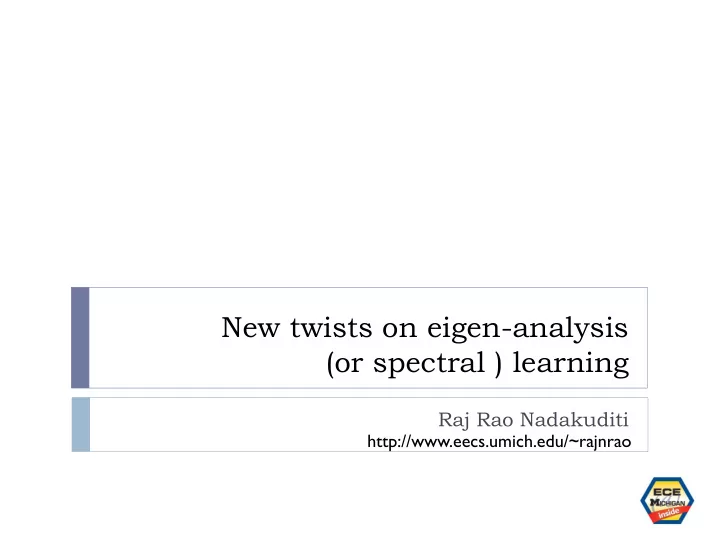

New twists on eigen-analysis (or spectral ) learning Raj Rao Nadakuditi http://www.eecs.umich.edu/~rajnrao
Role of eigen-analysis in Data Mining Prinicipal Component Analysis Latent Semantic Indexing Canonical Correlation Analysis Linear Discriminant Analysis Multidimensional Scaling Spectral Clustering Matrix Completion Kernalized variants of above Eigen-analysis synonymous with Spectral Dim. Red. 2
Mechanics of Dim. Reduction Many heuristics for picking dimension “Play-it-safe-and-overestimate” heuristic “Gap” heuristic “Percentage-of-explained-variance” heuristic 3
Motivation for this talk Large Matrix Valued Dataset Setting: High-Dimensional Latent Signal Variable + Noise “Out intuition in higher dimensions isn’t worth a damn” George Dantzig, MS Mathematics, 1938 U. of Michigan Random matrix theory = Science of eigen-analysis 4
New Twists on Spectral learning 1) All (estimated) subspaces are not created equal 2) Value to judicious dimension reduction 3) Adding more data can degrade performance Incorporated into next gen. spectral algorithms Improved, data-driven performance! Match or improve on state-of-the-art non-spectral techniques 5
Analytical model Low dimensional (= k) latent signal model X n is an n x m Gaussian “noise-only” matrix c = n/m = # rows / # columns of data set Theta ~ SNR 6
1) All estimated subspaces are not equal c = # rows / # columns in data set Theta ~ SNR Subspace estimates are biased (in geometric sense above) 7
2) Value of judicious dim. reduction “Playing-it-safe” heuristic injects additional noise! 8
Mechanics of Dim. Reduction Many heuristics for picking dimension “Play-it-safe-and-overestimate” heuristic “Gap” heuristic “Percentage-of-explained-variance” heuristic 9
What about the gap heuristic? No “gap” at breakdown point! 10
Percentage-of-variance heuristic? O(1) eigenvalues that look “continuous” are noise! Including those dimensions injects noise! Value of judicious dimension reduction! 11
3) More data can degrade performance c = n/m = # rows / # columns Consider n = m so c = 1 n’ = 2n, m’ = m New critical value = 2 1/4 x Old critical value! Weaker latent signals now buried! Value to adding “correlated” data and vice versa! 12
Role of eigen-analysis in Data Mining Prinicipal Component Analysis Latent Semantic Indexing Canonical Correlation Analysis Linear Discriminant Analysis Multidimensional Scaling Spectral Clustering Matrix Completion Kernalized variants of above Eigen-analysis synonymous with Spectral Dim. Red. 13
New Twists on Spectral learning 1) All (estimated) subspaces are not created equal 2) Value to judicious dimension reduction 3) Adding more data can degrade performance Incorporated into next gen. spectral algorithms Match or improve on state-of-the-art non-spectral techniques Role of random matrix theory in data-driven alg. design http://www.eecs.umich.edu/~rajnrao/research.html 14
Recommend
More recommend